belt VOLVO XC90 2007 Owners Manual
[x] Cancel search | Manufacturer: VOLVO, Model Year: 2007, Model line: XC90, Model: VOLVO XC90 2007Pages: 268, PDF Size: 8.57 MB
Page 1 of 268
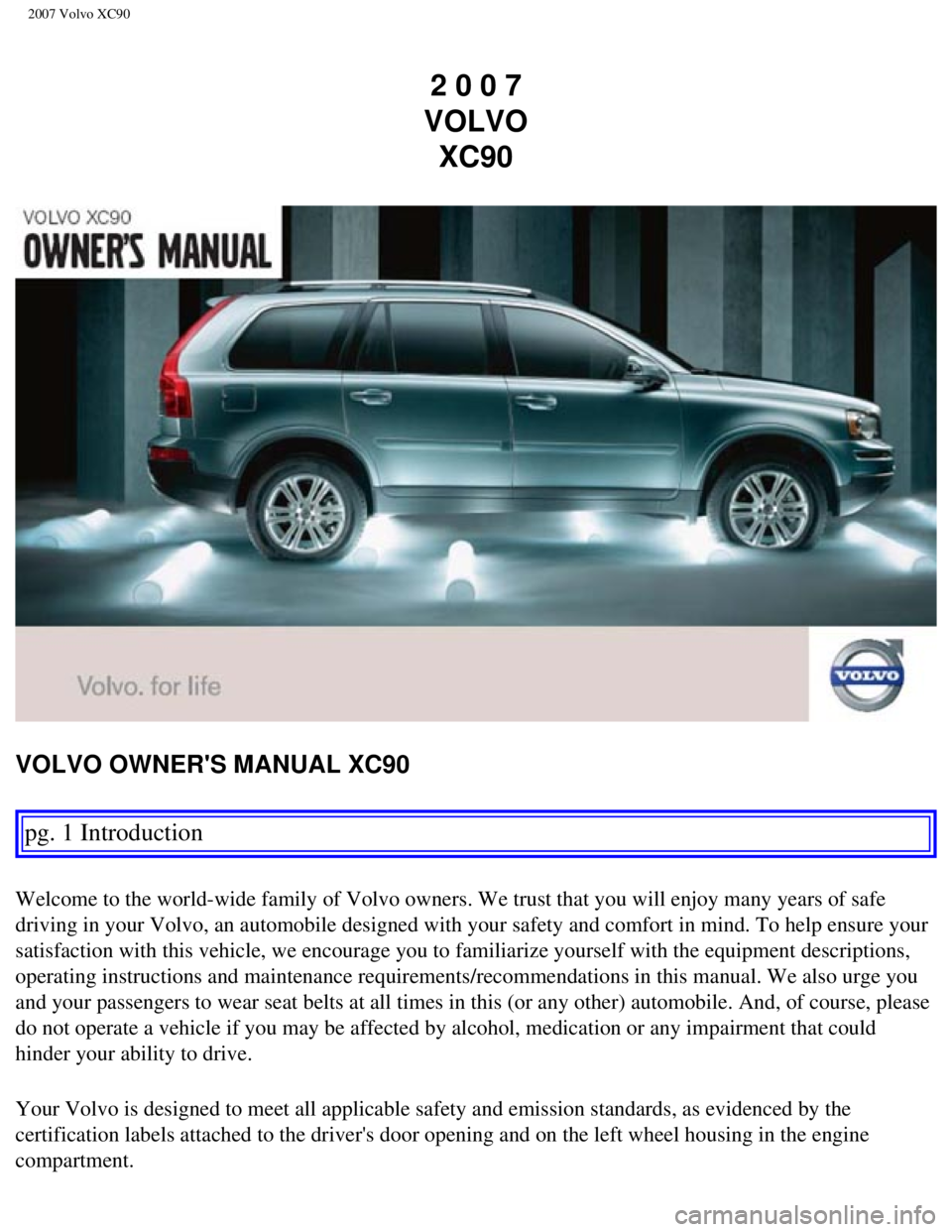
2007 Volvo XC90
2 0 0 7
VOLVO XC90
VOLVO OWNER'S MANUAL XC90
pg. 1 Introduction
Welcome to the world-wide family of Volvo owners. We trust that you will\
enjoy many years of safe
driving in your Volvo, an automobile designed with your safety and comfo\
rt in mind. To help ensure your
satisfaction with this vehicle, we encourage you to familiarize yourself\
with the equipment descriptions,
operating instructions and maintenance requirements/recommendations in t\
his manual. We also urge you
and your passengers to wear seat belts at all times in this (or any oth\
er) automobile. And, of course, please
do not operate a vehicle if you may be affected by alcohol, medication o\
r any impairment that could
hinder your ability to drive.
Your Volvo is designed to meet all applicable safety and emission standa\
rds, as evidenced by the
certification labels attached to the driver's door opening and on the le\
ft wheel housing in the engine
compartment.
file:///K|/ownersdocs/2007/2007_XC90/07xc90_00.htm (1 of 7)12/30/2006 \
5:53:31 PM
Page 8 of 268

2007 Volvo XC90
2 0 0 7
VOLVO XC90
Safety
pg. 9 Safety
Occupant safety, Reporting safety
defects
10
Seat belts
12
Supplemental Restraint System (SRS)
15
Front airbags
16
Occupant Weight Sensor (OWS)
20
Side impact (SIPS) airbag
24
Volvo Inflatable Curtain (VIC)
25
Whiplash Protection System (WHIPS)
26
Child safety
28
Child restraint systems
31
Infant seats
33
Convertible seats
35
Booster cushions
37
ISOFIX lower anchors
38
Top tether anchors
39
Integrated booster cushion
40
pg. 10 Safety
Occupant safety, Reporting safety defects
Volvo concern for safety
file:///K|/ownersdocs/2007/2007_XC90/07xc90_01.htm (1 of 39)12/30/2006\
5:53:33 PM
Page 9 of 268

2007 Volvo XC90
Safety is the Volvo cornerstone. Our concern dates back to 1927 when the\
first Volvo rolled off the
production line. Three-point seat belts (a Volvo invention), safety ca\
ges, and energy-absorbing impact
zones were designed into Volvo vehicles long before it was fashionable o\
r required by government
regulation. We will not compromise our commitment to safety. We continue\
to seek out new safety
features and to refine those already in our vehicles. You can help. We w\
ould appreciate hearing your
suggestions about improving automobile safety. We also want to know if y\
ou ever have a safety concern
with your vehicle. Call us in the U.S. at: 800-458-1552 or in Canada at:\
800-663- 8255.
Occupant safety
How safely you drive doesn't depend on how old you are but rather on:
l How well you see.
l Your ability to concentrate.
l How quickly you make decisions under stress to avoid an accident.
The tips listed below are suggestions to help you cope with the ever cha\
nging traffic environment.
l Never drink and drive.
l If you are taking any medication, consult your physician about its poten\
tial effects on your driving
abilities.
l Take a driver-retraining course.
l Have your eyes checked regularly.
l Keep your windshield and headlights clean.
l Replace wiper blades when they start to leave streaks.
l Take into account the traffic, road, and weather conditions, particularl\
y with regard to stopping
distance.
Reporting safety defects in the U.S.
If you believe that your vehicle has a defect which could cause a crash \
or could cause injury or death,
you should immediately inform the National Highway Traffic Safety Admini\
stration (NHTSA) in
addition to notifying Volvo Cars of North America, LLC. If NHTSA receive\
s similar complaints, it may
open an investigation, and if it finds that a safety defect exists in a \
group of vehicles, it may order a
recall and remedy campaign. However, NHTSA cannot become involved in ind\
ividual problems
between you, your retailer, or Volvo Cars of North America, LLC. To cont\
act NHTSA, you may either
call the Auto Safety Hotline toll-free at 1-888-327-4236 (TTY: 1-800-42\
4-9153) or write to: NHTSA, U.
S. Department of Transportation, Washington D.C. 20590.
You can also obtain other information about motor vehicle safety from:
http://www.safecar.gov
Volvo strongly recommends that if your vehicle is covered under a servic\
e campaign, safety or emission
recall or similar action, it should be completed as soon as possible. Pl\
ease check with your local retailer
or Volvo Cars of North America, LLC if your vehicle is covered under the\
se conditions.
file:///K|/ownersdocs/2007/2007_XC90/07xc90_01.htm (2 of 39)12/30/2006\
5:53:33 PM
Page 10 of 268

2007 Volvo XC90
NHTSA can be reached at:
Internet:
http://www.nhtsa.gov
Telephone:
1-888-DASH-2-DOT (1-888-327-4236).
pg. 11 Safety
Occupant safety, Reporting safety defects
Reporting safety defects in Canada
If you believe your vehicle has a defect that could cause a crash or cou\
ld cause injury or death, you
should immediately inform Transport Canada in addition to notifying Volv\
o Cars of Canada Corp.
To contact Transport Canada, call (800) 333-0510, or (613) 993-9851 \
if you are calling from the Ottawa
region.
pg. 12 Safety
Seat belts
Using seat belts
Volvo, the inventor of the three-point seat belt, urges you and all occu\
pants of your vehicle to wear seat
belts and ensure that children are properly restrained, using an infant,\
car, or booster seat determined by
age, weight and height.
Volvo also believes no child should sit in the front seat of a vehicle. \
Most states and provinces make it mandatory for occupants of a vehicle t\
o use seat belts.
Seat belt tensioners
file:///K|/ownersdocs/2007/2007_XC90/07xc90_01.htm (3 of 39)12/30/2006\
5:53:33 PM
Page 11 of 268

2007 Volvo XC90
The seat belts are equipped with tensioners that reduce slack in the bel\
ts. These tensioners are triggered
in situations where the airbags deploy. The front seat belts also includ\
e a tension reducing device which,
in the event of a collision, limits the peak forces exerted by the seat \
belt on the occupant.
Buckling a seat belt
Pull the belt out far enough to insert the latch plate into the receptac\
le until a distinct click is heard. The
seat belt retractor is normally "unlocked" and you can move freely, prov\
ided that the shoulder belt is not
pulled out too far.
The retractor will lock up as follows:
l if the belt is pulled out rapidly
l during braking and acceleration
l if the vehicle is leaning excessively
l when driving in turns
When wearing the seat belt remember:
l The belt should not be twisted or turned.
l The lap section of the belt must be positioned low on the hips (not pre\
ssing against the abdomen).
l Make sure that the shoulder belt is rolled up into its retractor and tha\
t the shoulder and lap belts are
taut.
Unbuckling the seat belt
To remove the seat belt, press the red section on the seat belt receptac\
le. Before exiting the vehicle,
check that the seat belt retracts fully after being unbuckled. If necess\
ary, guide the belt back into the
retractor slot.
Seat belt reminder
The seat belt reminder consists of an audible signal, an indicator light\
above the rearview mirror, and a
symbol in the instrument panel that alert the driver and front seat pass\
enger if their seat belts are not
fastened.
pg. 13 Safety
Seat belts
file:///K|/ownersdocs/2007/2007_XC90/07xc90_01.htm (4 of 39)12/30/2006\
5:53:33 PM
Page 12 of 268

2007 Volvo XC90
Seat belt use during pregnancy
The seat belt should always be worn during pregnancy. But it is crucial \
that it be worn in the correct
way. The diagonal section should wrap over the shoulder then be routed b\
etween the breasts and to the
side of the belly. The lap section should lay flat over the thighs and a\
s low as possible under the belly. It
must never be allowed to ride upward. Remove all slack from the belt and\
insure that it fits close to the
body without any twists.
As a pregnancy progresses, pregnant drivers should adjust their seats an\
d steering wheel such that they
can easily maintain control of the vehicle as they drive (which means t\
hey must be able to easily operate
the foot pedals and steering wheel). Within this context, they should s\
trive to position the seat with as
large a distance as possible between their belly and the steering wheel.\
Child seats
Please refer to
page 31 for information on securing child seats with the seat belts.
Seat belt maintenance
Check periodically that the seat belts are in good condition. Use water \
and a mild detergent for cleaning.
Check seat belt mechanism function as follows: attach the seat belt and \
pull rapidly on the strap.
file:///K|/ownersdocs/2007/2007_XC90/07xc90_01.htm (5 of 39)12/30/2006\
5:53:33 PM
Page 13 of 268
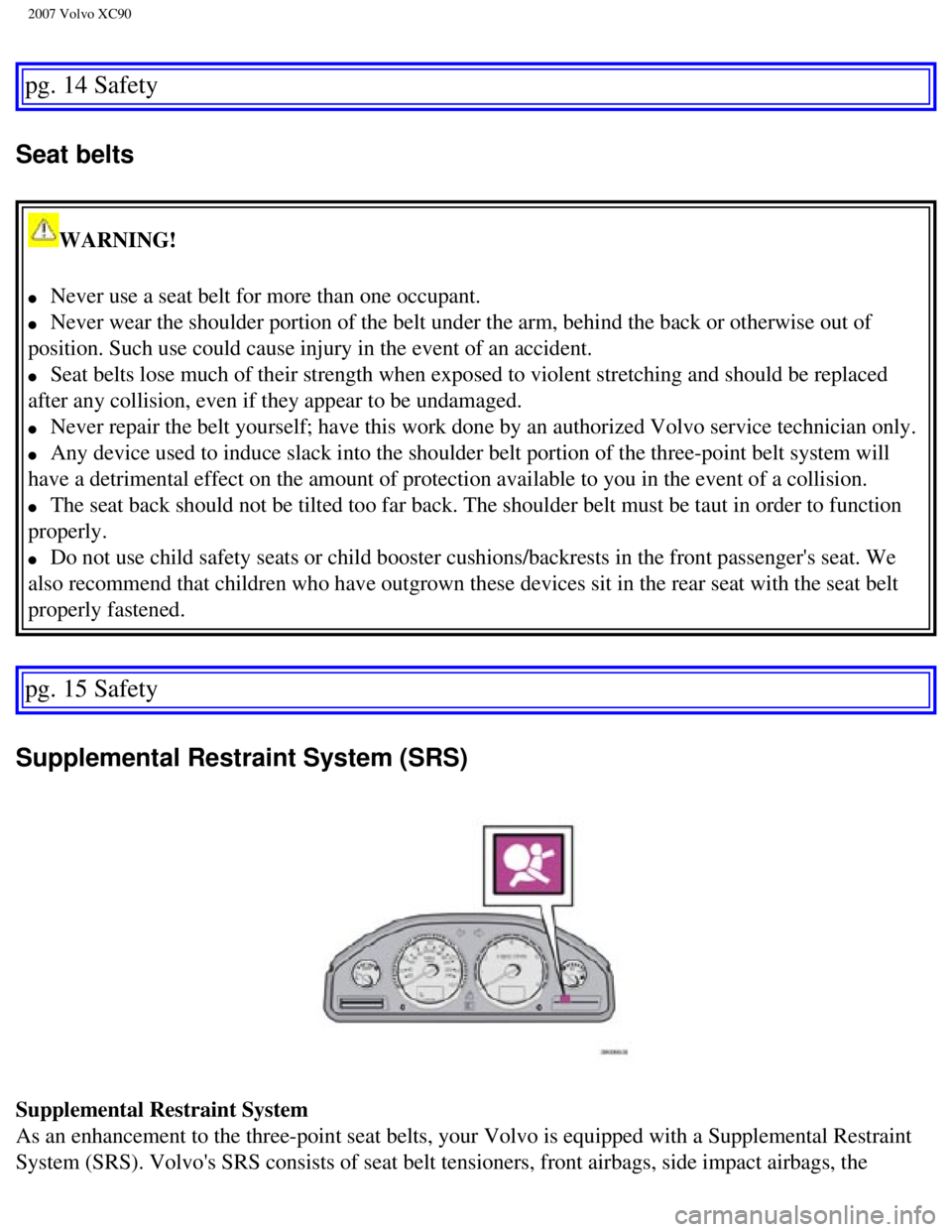
2007 Volvo XC90
pg. 14 Safety
Seat belts
WARNING!
l Never use a seat belt for more than one occupant.
l Never wear the shoulder portion of the belt under the arm, behind the ba\
ck or otherwise out of
position. Such use could cause injury in the event of an accident.
l Seat belts lose much of their strength when exposed to violent stretchin\
g and should be replaced
after any collision, even if they appear to be undamaged.
l Never repair the belt yourself; have this work done by an authorized Vol\
vo service technician only.
l Any device used to induce slack into the shoulder belt portion of the th\
ree-point belt system will
have a detrimental effect on the amount of protection available to you i\
n the event of a collision.
l The seat back should not be tilted too far back. The shoulder belt must \
be taut in order to function
properly.
l Do not use child safety seats or child booster cushions/backrests in the\
front passenger's seat. We
also recommend that children who have outgrown these devices sit in the \
rear seat with the seat belt
properly fastened.
pg. 15 Safety
Supplemental Restraint System (SRS)
Supplemental Restraint System
As an enhancement to the three-point seat belts, your Volvo is equipped \
with a Supplemental Restraint
System (SRS). Volvo's SRS consists of seat belt tensioners, front airb\
ags, side impact airbags, the
file:///K|/ownersdocs/2007/2007_XC90/07xc90_01.htm (6 of 39)12/30/2006\
5:53:33 PM
Page 15 of 268
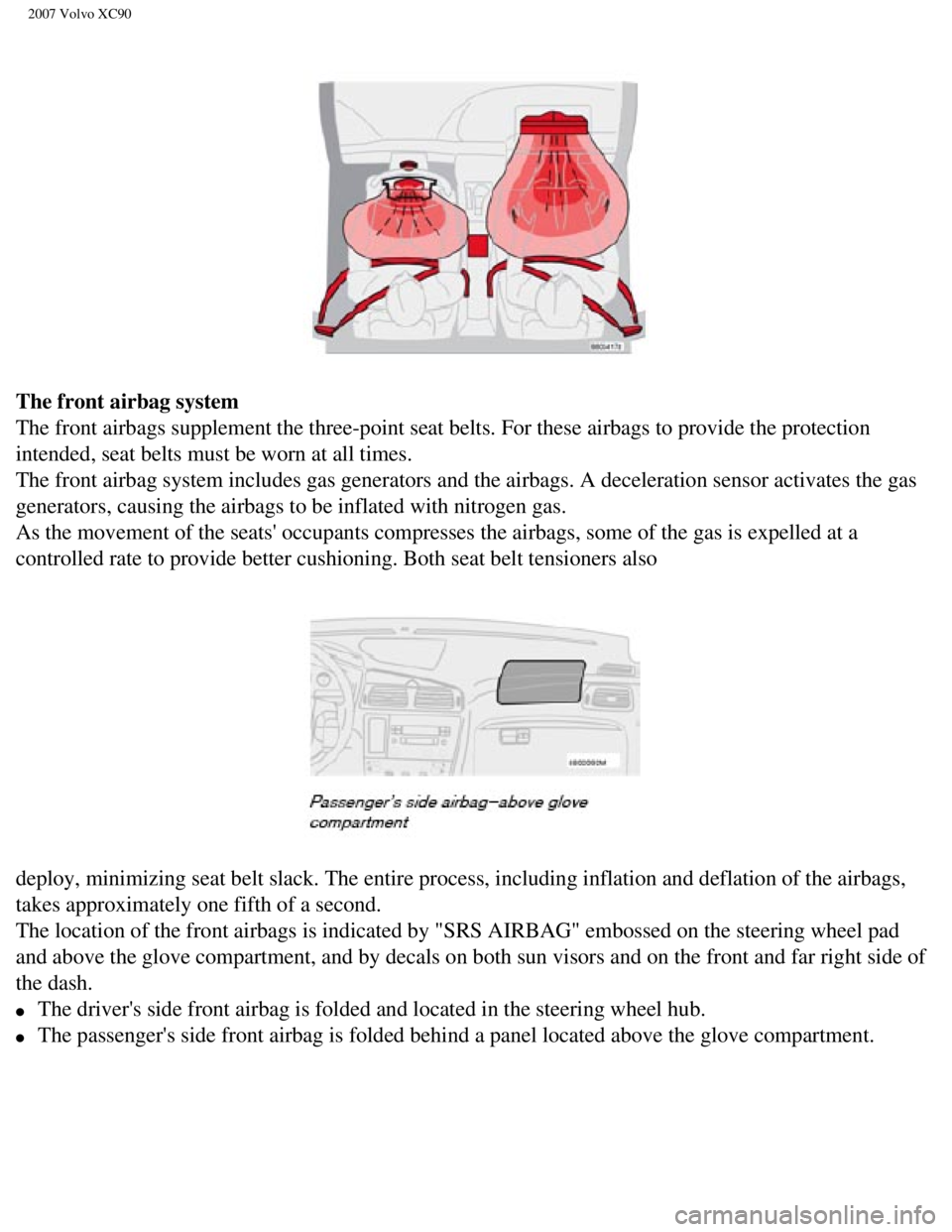
2007 Volvo XC90
The front airbag system
The front airbags supplement the three-point seat belts. For these airba\
gs to provide the protection
intended, seat belts must be worn at all times.
The front airbag system includes gas generators and the airbags. A decel\
eration sensor activates the gas
generators, causing the airbags to be inflated with nitrogen gas.
As the movement of the seats' occupants compresses the airbags, some of \
the gas is expelled at a
controlled rate to provide better cushioning. Both seat belt tensioners \
also
deploy, minimizing seat belt slack. The entire process, including inflat\
ion and deflation of the airbags,
takes approximately one fifth of a second.
The location of the front airbags is indicated by "SRS AIRBAG" embossed \
on the steering wheel pad
and above the glove compartment, and by decals on both sun visors and on\
the front and far right side of
the dash.
l The driver's side front airbag is folded and located in the steering whe\
el hub.
l The passenger's side front airbag is folded behind a panel located above\
the glove compartment.
file:///K|/ownersdocs/2007/2007_XC90/07xc90_01.htm (8 of 39)12/30/2006\
5:53:33 PM
Page 16 of 268
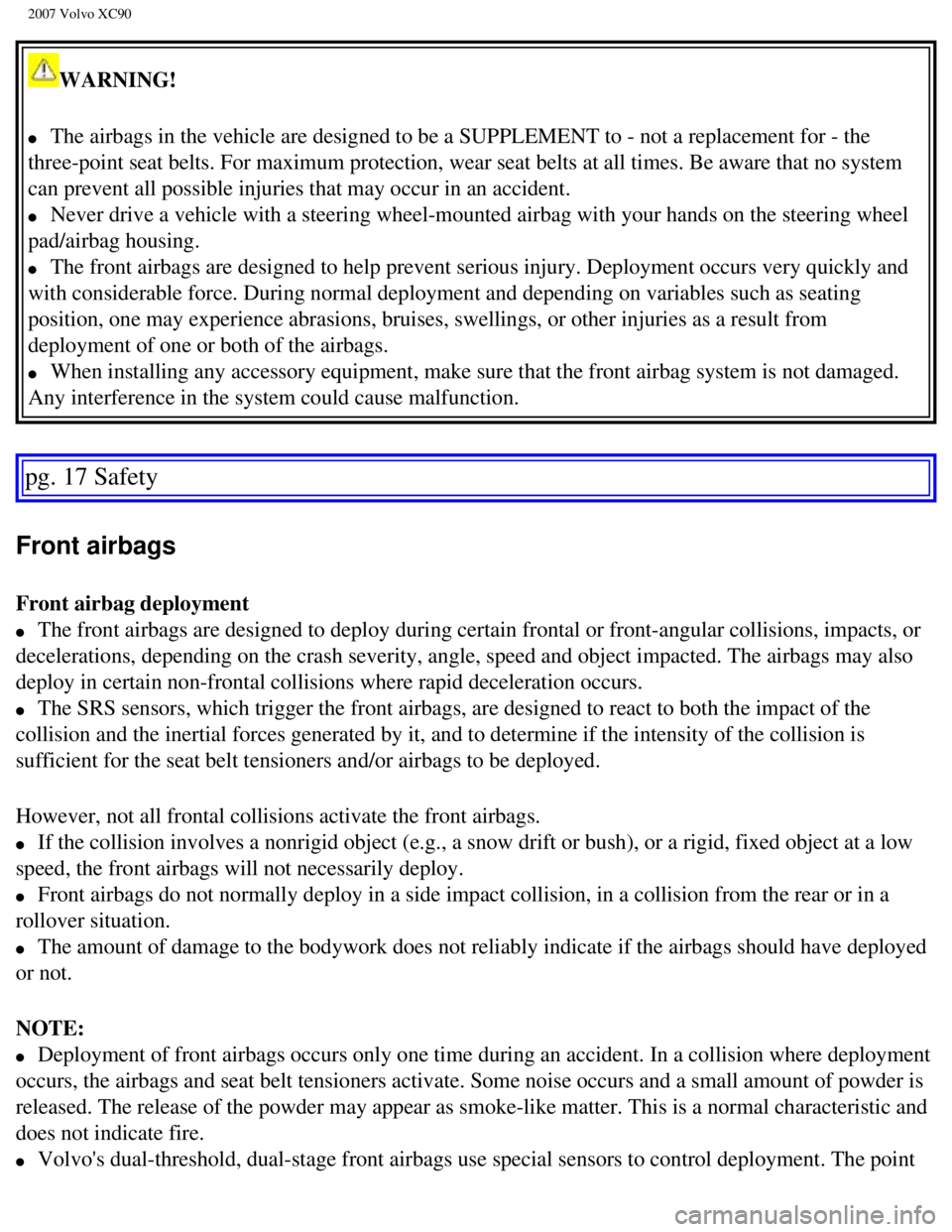
2007 Volvo XC90
WARNING!
l The airbags in the vehicle are designed to be a SUPPLEMENT to - not a re\
placement for - the
three-point seat belts. For maximum protection, wear seat belts at all t\
imes. Be aware that no system
can prevent all possible injuries that may occur in an accident.
l Never drive a vehicle with a steering wheel-mounted airbag with your han\
ds on the steering wheel
pad/airbag housing.
l The front airbags are designed to help prevent serious injury. Deploymen\
t occurs very quickly and
with considerable force. During normal deployment and depending on varia\
bles such as seating
position, one may experience abrasions, bruises, swellings, or other inj\
uries as a result from
deployment of one or both of the airbags.
l When installing any accessory equipment, make sure that the front airbag\
system is not damaged.
Any interference in the system could cause malfunction.
pg. 17 Safety
Front airbags
Front airbag deployment
l The front airbags are designed to deploy during certain frontal or front\
-angular collisions, impacts, or
decelerations, depending on the crash severity, angle, speed and object \
impacted. The airbags may also
deploy in certain non-frontal collisions where rapid deceleration occurs\
.
l The SRS sensors, which trigger the front airbags, are designed to react \
to both the impact of the
collision and the inertial forces generated by it, and to determine if t\
he intensity of the collision is
sufficient for the seat belt tensioners and/or airbags to be deployed.
However, not all frontal collisions activate the front airbags.
l If the collision involves a nonrigid object (e.g., a snow drift or bush\
), or a rigid, fixed object at a low
speed, the front airbags will not necessarily deploy.
l Front airbags do not normally deploy in a side impact collision, in a co\
llision from the rear or in a
rollover situation.
l The amount of damage to the bodywork does not reliably indicate if the a\
irbags should have deployed
or not.
NOTE:
l Deployment of front airbags occurs only one time during an accident. In \
a collision where deployment
occurs, the airbags and seat belt tensioners activate. Some noise occurs\
and a small amount of powder is
released. The release of the powder may appear as smoke-like matter. Thi\
s is a normal characteristic and
does not indicate fire.
l Volvo's dual-threshold, dual-stage front airbags use special sensors to \
control deployment. The point
file:///K|/ownersdocs/2007/2007_XC90/07xc90_01.htm (9 of 39)12/30/2006\
5:53:33 PM
Page 17 of 268
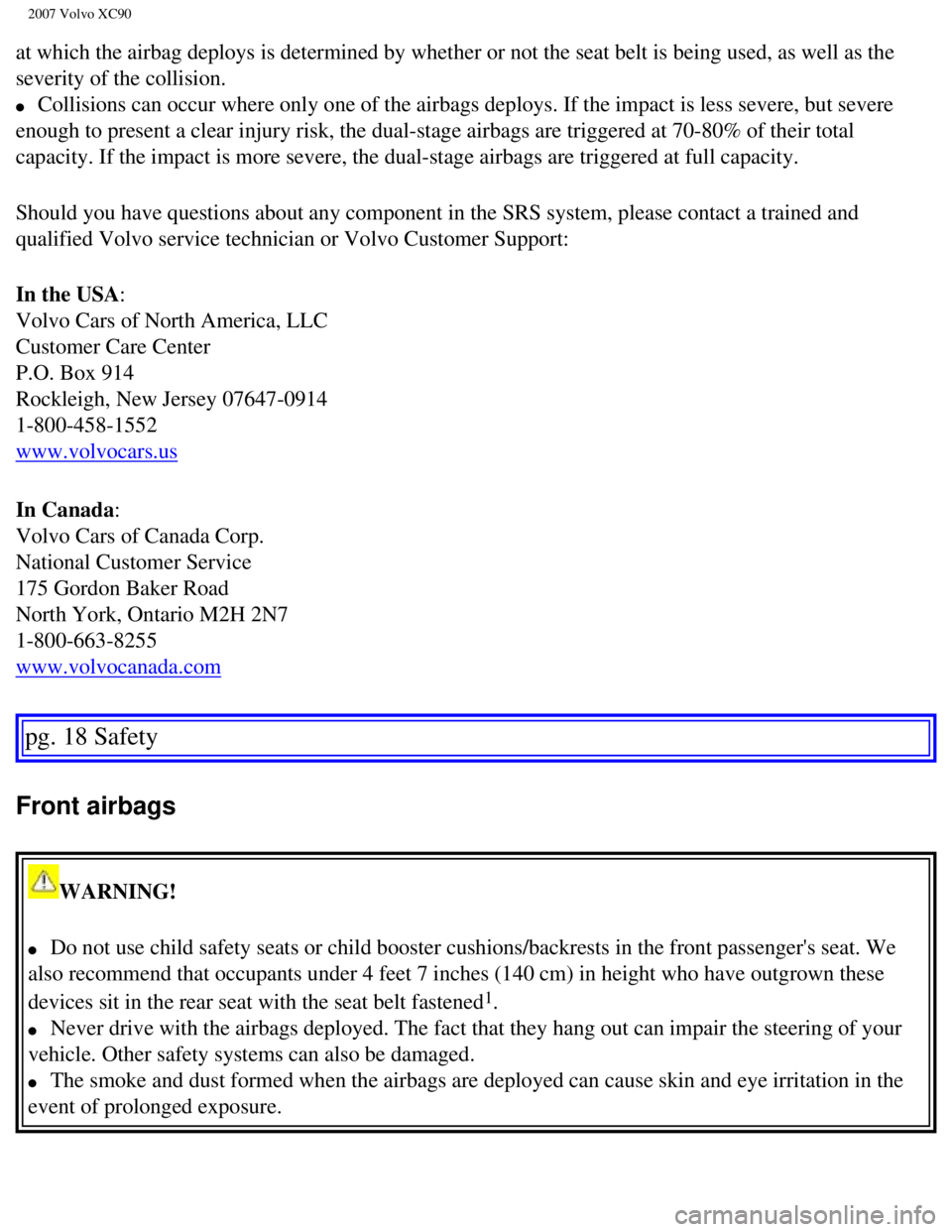
2007 Volvo XC90
at which the airbag deploys is determined by whether or not the seat bel\
t is being used, as well as the
severity of the collision.
l Collisions can occur where only one of the airbags deploys. If the impac\
t is less severe, but severe
enough to present a clear injury risk, the dual-stage airbags are trigge\
red at 70-80% of their total
capacity. If the impact is more severe, the dual-stage airbags are trigg\
ered at full capacity.
Should you have questions about any component in the SRS system, please \
contact a trained and
qualified Volvo service technician or Volvo Customer Support:
In the USA:
Volvo Cars of North America, LLC
Customer Care Center
P.O. Box 914
Rockleigh, New Jersey 07647-0914
1-800-458-1552
www.volvocars.us
In Canada:
Volvo Cars of Canada Corp.
National Customer Service
175 Gordon Baker Road
North York, Ontario M2H 2N7
1-800-663-8255
www.volvocanada.com
pg. 18 Safety
Front airbags
WARNING!
l Do not use child safety seats or child booster cushions/backrests in the\
front passenger's seat. We
also recommend that occupants under 4 feet 7 inches (140 cm) in height\
who have outgrown these
devices sit in the rear seat with the seat belt fastened
1.
l Never drive with the airbags deployed. The fact that they hang out can i\
mpair the steering of your
vehicle. Other safety systems can also be damaged.
l The smoke and dust formed when the airbags are deployed can cause skin a\
nd eye irritation in the
event of prolonged exposure.
file:///K|/ownersdocs/2007/2007_XC90/07xc90_01.htm (10 of 39)12/30/200\
6 5:53:33 PM